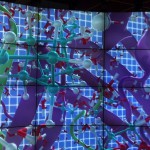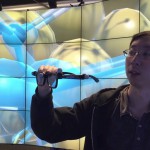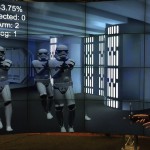By Siying Li, Video by Chencheng Zhao
When Star Wars’ creator George Lucas envisioned the Death Star as a huge and deadly space station, capable of destroying a planet with a single shot of aa super laser, he turned to at the University of Illinois at Chicago.
The original model, featured in the first Star Wars film, was built there at the university’s Electronic Visualization Laboratory.
The iconic film from 1977 made its latest comeback in late 2015 with the release of “Star Wars: The Force Awakens,” And so did a re-imagined Death Star, again created at UIC.
Arthur Nishimoto, a second-year computer science doctoral student and research associate at EVL, is a Star Wars fan. He worked in his spare time to bring back the Death Star with virtual reality technology.
“What’s cool about my Death Star simulation is that it’s built at the actual size of a moon virtually,” he said. “It’s not just making a model of the Death Star. It’s making a Death Star at full scale.”
And you can walk inside this Dealth Star.
Nishimoto built his new Death Star model in EVL’s CAVE2, a system that combines display walls and virtual reality to create a seamless 2-D/3-D environment.
“CAVE2 is a ‘hybrid’ space as it has the benefits of both a project room and an immersive environment,” explained Maxine Brown, director of EVL. The CAVE2 was designed to be a tool for scientific visualization and collaboration.

CAVE2 provides users with a 320-degree panoramic virtual reality display. The circular room is surrounded by 72 3-D TVs connected to 36 computers, a 20.2-channel surround audio system and a 14-camera optical tracking system.
“The tracking system is the key component here,” said Nishimoto, pointing at the tracking markers on the 3-D glasses he was wearing. The infrared cameras pick up the markers so that the computers know exactly the position and the orientation of the glasses. When a user wearing these glasses moves in the space, the computers redraw the scene to their perspective, so the user seemingly can walk around the virtual objects as if they were really there in front of you.
“Otherwise, it would just be a big 3-D TV wall, ” he said.
“I feel fortunate to have CAVE2 as an ultimate canvas to work on and view my artworks,” said Nishimoto, as he opened a door inside the Death Star with a computer-generated laser pointer.
He said he decided to build a Death Star model in CAVE2 as soon as he found out that a new Star Wars movie was coming out in 2015.
“I had the right interest at the right place, ” he said.
[vimeo 158216999 w=474]
EVL developed the first Death Star model in 1977. Home to many digital artworks, the lab was founded in 1973 with the goal of fostering interdisciplinary collaborations between artists and scientists.
“I’d like to think beyond the model—for example, I can make this ship fly around the Death Star like in any video game, but what if this is actually a real ship that we can apply real physics to it? ” Nishimoto said. “I always try to bring real science back into the fictional world.”
CAVE2 helps this happen, even for researchers besides computer scientists and video game designers.
Psychiatrists have brought the MRI diffusion tensor imagining “wiring diagrams” of the brains into CAVE2 so they could spend the whole afternoon walking around the nerves and exploring a detailed map of neural connections in the brain, Nishimoto said.
UIC was also one of the users of the virtual reality system. Last year, the university brought an architectural blueprint of a proposed new Computer Science building into the CAVE2 so that people could get a feeling of walking through the rooms and hallways and evaluate the design before finalizing the plan.
There is a lot of ongoing research.
“I’d certainly like to do my Ph.D. dissertation in here, maybe focusing on user interactions, ” Nishimoto said. “How can we interact with the virtual world even more? Is it using voice recognition? Can I grab something using the motion tracker without using a wand?”
His research will continue as Nishimoto modifies his moon-sized model of the Death Star. After seeing the movie last year, Nishimoto also built a model of the Han Solo’s Millennium Falcon and placed it inside the Death Star.
“Again, there are a lot of details to work out. I spent late nights and weekends working on just one piece of the Falcon’s cockpit, ” Nishimoto said.
“But that’s what I enjoy about computer science and 3-D modeling. You really can build whatever you want and use something like the CAVE2 to step into it and be inside, looking out,”





